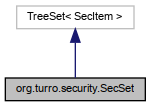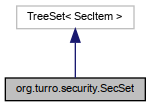- Author
- Lluis Turró Cutiller lluis.nosp@m.@tur.nosp@m.ro.or.nosp@m.g
Definition at line 31 of file SecSet.java.
◆ SecSet()
| org.turro.security.SecSet.SecSet |
( |
Collection<? extends SecItem > |
c | ) |
|
◆ empty()
| static SecSet org.turro.security.SecSet.empty |
( |
| ) |
|
|
static |
Definition at line 121 of file SecSet.java.
122 return new SecSet(Collections.EMPTY_SET);
SecSet(Collection<? extends SecItem > c)
◆ getMaxUsage()
| long org.turro.security.SecSet.getMaxUsage |
( |
| ) |
|
Definition at line 110 of file SecSet.java.
111 return stream().mapToLong(t -> t.getUsage()).max().orElse(0);
◆ getSecNames()
| TreeSet<String> org.turro.security.SecSet.getSecNames |
( |
| ) |
|
Definition at line 90 of file SecSet.java.
91 return new TreeSet(stream().map(t -> t.getSecName()).collect(Collectors.toSet()));
◆ getSelected()
| TreeSet<SecItem> org.turro.security.SecSet.getSelected |
( |
| ) |
|
Definition at line 94 of file SecSet.java.
95 return new TreeSet(stream().filter(t -> t.isSelected()).collect(Collectors.toSet()));
◆ getSelectedSecNames()
| TreeSet<String> org.turro.security.SecSet.getSelectedSecNames |
( |
| ) |
|
Definition at line 102 of file SecSet.java.
103 return new TreeSet(stream().filter(t -> t.isSelected()).map(t -> t.getSecName()).collect(Collectors.toSet()));
◆ getUnselected()
| TreeSet<SecItem> org.turro.security.SecSet.getUnselected |
( |
| ) |
|
Definition at line 98 of file SecSet.java.
99 return new TreeSet(stream().filter(t -> !t.isSelected()).collect(Collectors.toSet()));
◆ getUnselectedSecNames()
| TreeSet<String> org.turro.security.SecSet.getUnselectedSecNames |
( |
| ) |
|
Definition at line 106 of file SecSet.java.
107 return new TreeSet(stream().filter(t -> !t.isSelected()).map(t -> t.getSecName()).collect(Collectors.toSet()));
◆ markSiblingsFromSelection()
| void org.turro.security.SecSet.markSiblingsFromSelection |
( |
| ) |
|
Definition at line 114 of file SecSet.java.
117 sec.setSibling(siblings.contains(sec));
TreeSet< SecItem > getUnselected()
TreeSet< String > getSelectedSecNames()
◆ secUrl()
| String org.turro.security.SecSet.secUrl |
( |
SecItem |
sec | ) |
|
Definition at line 86 of file SecSet.java.
87 return MarkerHelper.setObfuscatedRightNowPars(
"sec=" + sec.getSecName());
◆ select()
| void org.turro.security.SecSet.select |
( |
String |
secName | ) |
|
Definition at line 37 of file SecSet.java.
38 for(SecItem t :
this) {
39 if(t.getSecName().equals(secName)) {
◆ selectAll()
| void org.turro.security.SecSet.selectAll |
( |
| ) |
|
Definition at line 68 of file SecSet.java.
69 for(SecItem t :
this) {
◆ toggle() [1/2]
| void org.turro.security.SecSet.toggle |
( |
| ) |
|
Definition at line 80 of file SecSet.java.
81 for(SecItem t :
this) {
82 t.setSelected(!t.isSelected());
◆ toggle() [2/2]
| void org.turro.security.SecSet.toggle |
( |
String |
secName | ) |
|
Definition at line 53 of file SecSet.java.
54 for(SecItem t :
this) {
55 if(t.getSecName().equals(secName)) {
58 }
else if(t.isSibling()) {
◆ unselect()
| void org.turro.security.SecSet.unselect |
( |
String |
secName | ) |
|
Definition at line 45 of file SecSet.java.
46 for(SecItem t :
this) {
47 if(t.getSecName().equals(secName)) {
◆ unselectAll()
| void org.turro.security.SecSet.unselectAll |
( |
| ) |
|
Definition at line 74 of file SecSet.java.
75 for(SecItem t :
this) {
The documentation for this class was generated from the following file:







